Wine Tasting Etiquette | How to act on a wine tasting night
Are you a wine lover? Do you dream of going to Napa Valley, France or Italy to enjoy the scenery and taste great wines? Or do you just want to go to a nearby wine bar to learn more about the Pinot Noir or Cabernet Sauvignon you love so much?
Are you also wondering about the right wine tasting label so you don’t make a fool of yourself?
We’ll give you the right wine tasting etiquette tips to help you get the most out of your tasting room experience and not look like an amateur!
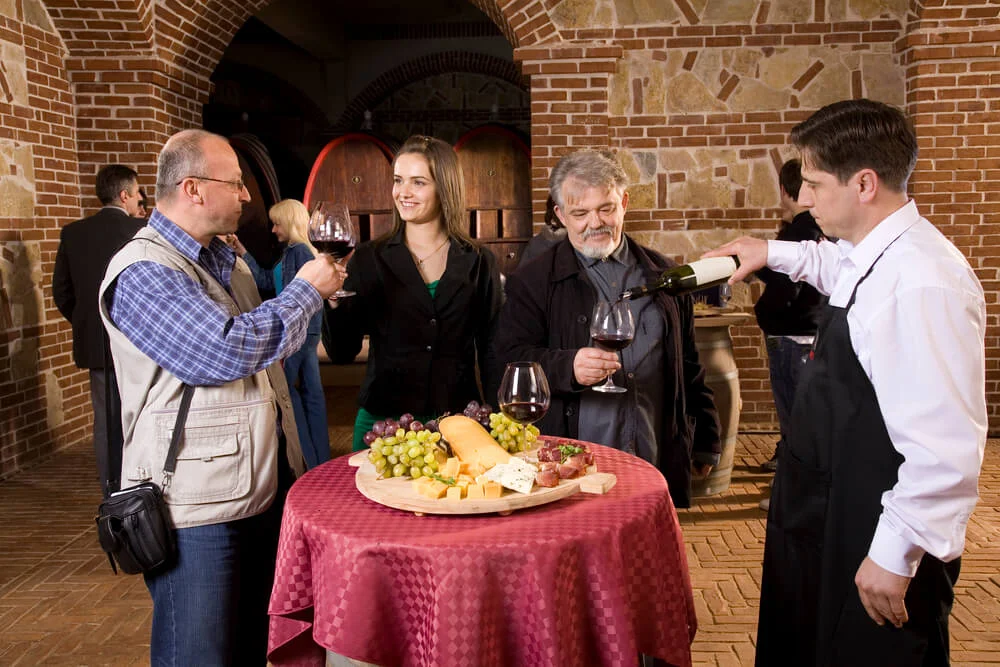
How does wine tasting work?
Wine tasting is a sensory experience that uses all of your senses to help you understand and assess a wine’s qualities.
When tasting wine, you first examine the color, purity, and strength of the liquid. You may smell the scent of the wine by swirling it in your glass; when you inhale, you’ll be able to distinguish flavors like fruits, florals, spices, and oak.
The wine then coats your palate as you take a sip, allowing you to taste its tastes, acidity, sweetness, and tannins. The mouthfeel or texture of the wine, which can range from light and crisp to rich and velvety, also influences how it tastes.
In the end, you spit the wine out or swallow it, depending on how many wines you are tasting.
Pay attention to the finish or aftertaste, which may linger on your palate. Take your time, enjoy each sip, and pay attention to how the wine changes as it warms in your mouth.
Everybody has a different palate, and wine tasting is a personal experience that can be as straightforward or intricate as you like. Let’s toast to learning about and taking in the great world of wine!
Preparing for a Tasting
It’s not just about picking up the wine country, winery, or tasting room you want to visit, there is more to the preparation itself. Below you’ll find some basic information on what to do before you visit the tasting room.
If you’re new to wine tasting, it’s a good idea to familiarize yourself with some common wine words before your visit. Check our glossary of wine terms on the link.
Research the Wines and Winery ahead of Time
Plan ahead and do some research on the wineries you’re about to visit. Can you imagine going to a winery that’s known for its white wines and requesting to try a red wine? Familiarize yourself with the most popular wine types beforehand. You can avoid awkward questions like that by doing some research.
Most wineries already have a website, that you can browse through. Find out what kind of wines they make, what are they known for and perhaps a little bit about their history.
Usually, there are more wines in a winery that you can try in an hour or two, so you can get a list of wines beforehand and prepare a basic tasting plan.
There are different types of wine tasting. You can go through every type of wine, trying one sample representing each type. Start with light sparkling wines and slowly move on to more tannic ones. Another type of wine tasting is trying different samples of the same type of wine, perhaps different samples of Chardonnay. It all depends on your preferences and what the winery or tasting room has to offer.
While researching your wineries also make sure if you need a reservation for the visit or not. And if so, make a reservation.
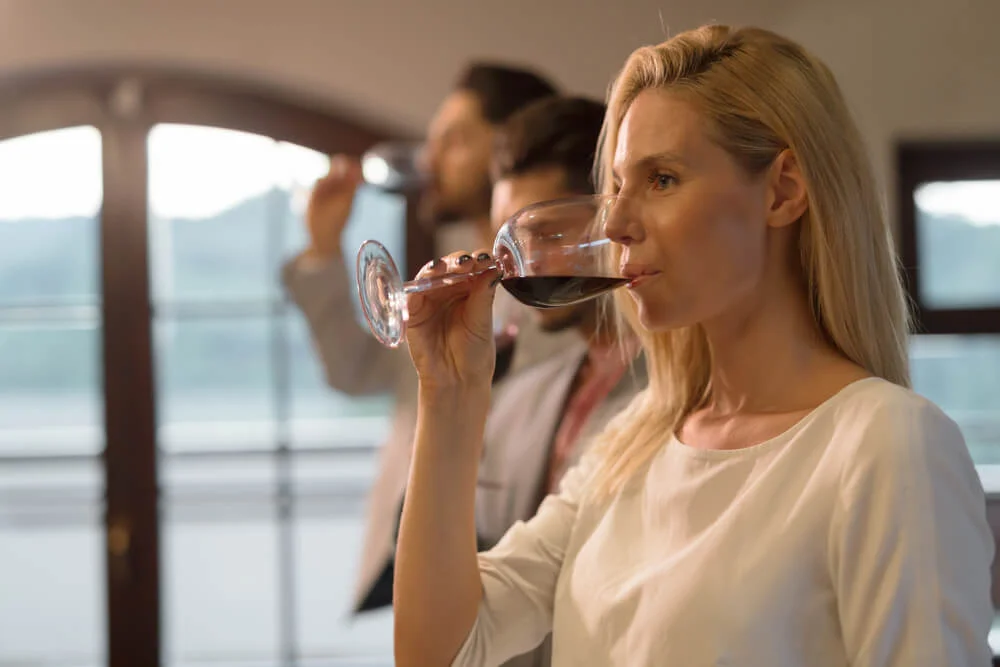
Dress appropriately
Even if you sometimes sit on the couch in your sweats while emptying a bottle of wine, perhaps this is not the right attire for a wine tasting. Wine tasting events are still considered a sophisticated activity so try to wear something elegant or casually elegant.
It’s advisable to choose dark colors, so if you get a spill on your shirt it won’t be noticeable. Try putting on layers because it can be warm outside but in the cellar, it’s going to be cold.
Women should put on some flats because there is going to be a lot of standing and walking. You will probably also go and see the grounds, which means uneven ground, from cobblestone pavement to mud in the vineyards.
For those who want to take notes, think about where you’re going to stash that notebook or smartphone. Use a deep pocket or a purse, since your hands will be full. There will most likely be a glass of wine in one hand and in the other some food or you’ll use it for shaking hands.
Avoid wearing Fragrance
Wine is about taste, feel, and smell. So you can imagine that wearing heavy perfumes can influence your experience and you won’t be able to appreciate all the nuances of wine’s aroma.
To get the full experience avoid wearing a strong perfume, cologne, or deodorant. Even try to avoid eating or drinking something with a strong flavor, since this will also affect how you’ll experience your drink. And another tip, leave the chewing gum in your pocket.
Don’t Drink on an Empty Stomach
This is a general rule for every kind of alcohol tasting. Yes, it’s hard to avoid getting drunk while tasting wine or drinking alcohol in general, but there are still some ways you can slow the process of getting intoxicated. The main tip is, don’t drink on an empty stomach.
Don’t count on the snacks at the wineries, since those are there mostly to accompany the wine or to cleanse your palate. They won’t make you full neither is this the purpose of this kind of service at wineries and tasting rooms.
So eat something before coming to a winery. And perhaps think also about who is going to be the designated driver.
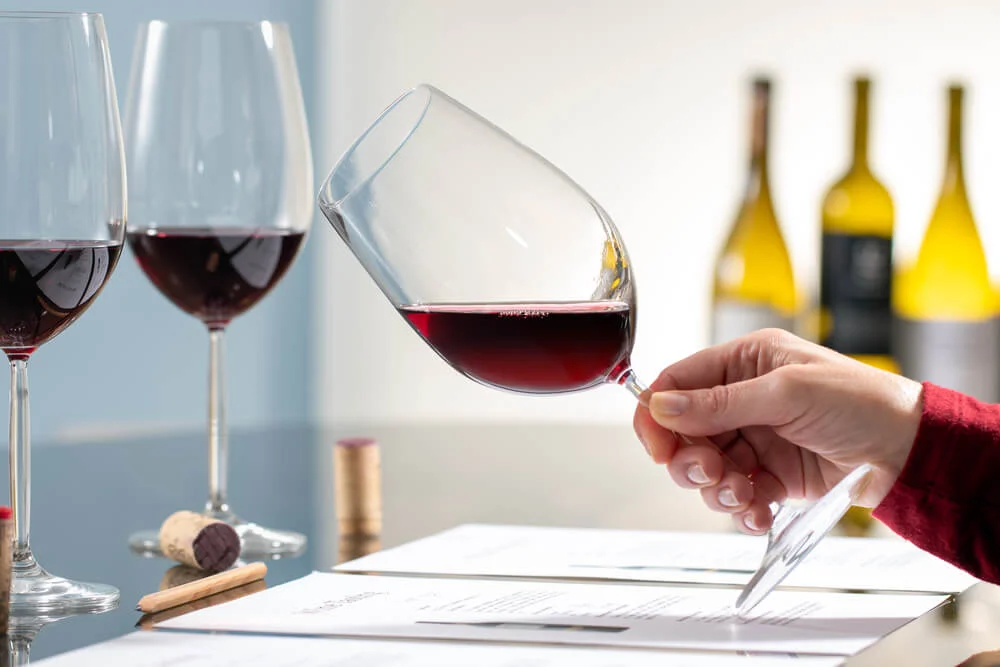
Arrive on Time
It’s rude to be late no matter the event and this goes especially for wine tasting. If you made a reservation be there on time.
Usually, there is more than one group coming to a wine tasting, so it can happen that you won’t be alone and everyone will be waiting for you or you’ll miss a part of the tour.
During the Tasting
So there you are at your wine tasting, where you arrived on time and now you can finally dive into the wine world. But are there things that you need to observe during the event? Yes, there are and we’ve got you covered.
Start Light
There are different types of wine tastings. Some tasting rooms provide packages and everything is guided by wine professionals, whereas sometimes you get a menu and you choose from it.
With the first type, you don’t have to worry about which wine you should try first. Usually, the host will provide everything for the wine tasting. But if you get a menu or go to an event, where there are many booths and types of wine, start with the light-bodied wines and work your way to the full-bodied and sweet wines.
Don’t be scared to try something new or something you think you won’t like. Be curious and have fun.
There are so many different types of wine and every winemaker has his twist on them. Don’t be the one, that goes to a wine tasting and says, “No, I won’t try that, because I don’t like dry wines”. You will very likely be pleasantly surprised.
Take Notes
Smart people write. Even if you think you’ll remember the Bordeaux you liked, believe us that after just a couple of drinks or even a couple of days of tasting wines, you won’t remember a thing.
So it’s best to keep a notebook or smartphone close to you, so you can keep notes on the new wines that you like and on the ones you didn’t like. The easiest thing is to just write down the name and a plus or minus beside it.
You can also just snap a photo of the bottles you tasted and liked.
At the end of your wine tasting experience, you’ll have a comprehensive list of every wine you tried and how you felt about it.
This will help you if you decide to purchase some bottles at the end of your tasting.
In most tasting rooms and wineries, you can buy wines or join a wine club. With this, you show support and it’s a great way to have a keepsake for when you come home.
But just so you know, it’s not mandatory to purchase a bottle of wine. But you might get a discount on your tasting fee or even get complimentary tastings.
Pace Yourself
Perhaps you feel anxious that you finally made it to the tasting and want to try everything at once, but it’s better to take your time and go through the adventure slowly.
Don’t go from one glass to another in under five minutes. Try to enjoy every sip of the delightful drink in your glass.
It is advisable to drink water in between, this will help to keep your head fresh longer.
Don’t be afraid to use the spitter if you feel that your head is getting heavy. It is also perfectly normal that you don’t empty the whole glass, you can pour it out and continue to the next one.
Every person has his limits when it comes to his alcohol levels. So observe yours and don’t try to go over it, because it will leave the tasting in a foggy memory at best and we wouldn’t like to talk about the worst case scenario.
Be Polite to the Other Tasters and the Host
Don’t be impatient while the wine steward is pouring your wine. It’s best to wait until he finishes his presentation before you start drinking.
If there is a big group at the wine tasting, try to be polite to other guests. Don’t hog the table with the glasses or the spittoon. Take your glass and move away from the table. Try to avoid jostling.
Try to listen to the stories behind each bottle. Give the wine professional a chance to explain what you are savoring. This will make your wine tasting experience more memorable.
You can also ask questions, and you can be curious about different types of wine and what makes them special.
But don’t pretend you know everything, just so you might get a discount. But this doesn’t mean you can’t show that you’re passionate about wine.
If you go to a winery and you want to stroll the scenic grounds, please ask beforehand. There can be a lot of equipment and machinery around the vineyard and perhaps there’s work going on, so it’s better to ask politely before you want to go for a walk.
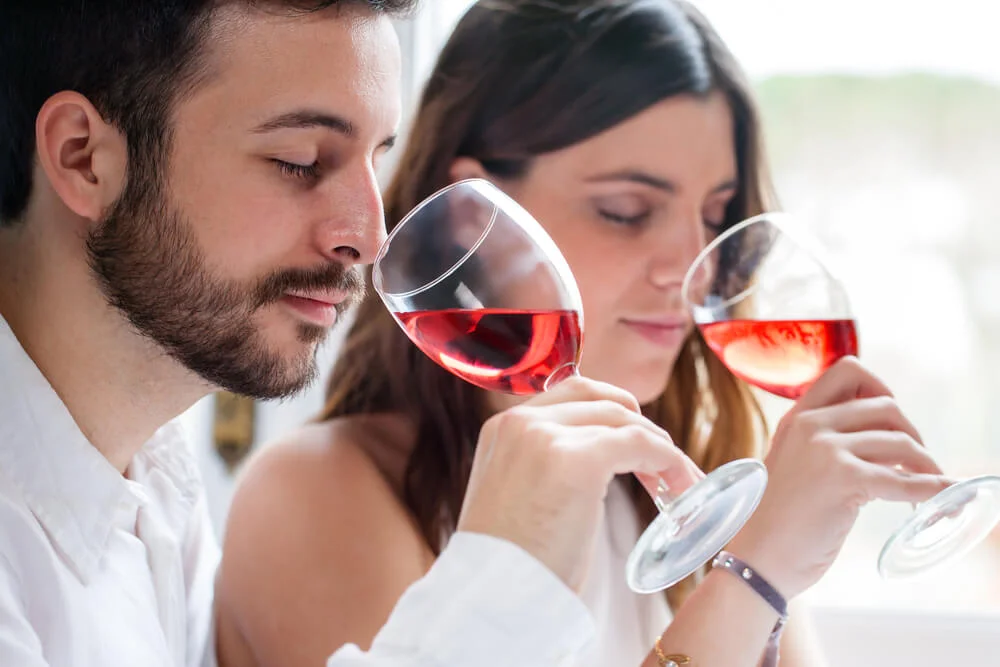
Tasting Techniques
Perhaps you’re wondering about the right tasting technique, we’ve gathered some basic guidelines that you need to follow.
The Look
Look at the wine’s color and clarity to evaluate its age and quality. Take your time evaluating the appearance of great wines.
Try putting your glass towards the light and see how the color changes. What does it remind you of, is the wine clear or is it cloudy? If you’re tasting sparkling wine, admire the bubbles. Are they small or big, are there lots of them? Try to spot the differences between different wines just by the look.
The Swirl
After you took your time observing the color, try to swirl the wine in your glass. Be focused on the viscosity, do the droplets stick to the rim of the glass? If more droplets are sticking to the side of the glass, this means the wine has a higher alcohol content and if they flow back to the bottom quickly, you probably have a lighter wine in front of you.
Another benefit of swirling the wine is that you also release its aromas.
The Smell
Smell the wine to evaluate its bouquet and complexity.
Bring the glass to your nose and take a deep breath. What do you notice? What kind of a taste do you anticipate if you think of the aromas that you smell? Try to notice if something is missing, what don’t you smell?
The Taste
Taste the wine to evaluate its flavor, acidity, tannins, and finish. Taste the wine in small sips, not large gulps.
Let it swirl in your mouth and enjoy the feel, the texture, and the taste. By swirling it you will get the whole experience and palate of tasting.
Also, be observant of what lingers in your mouth after you swallow it or spit it out.
How to Hold the Glass
You are probably used to holding the glass by the bowl since it’s easier to grab. But this is not the right wine etiquette. You’re supposed to hold it by the steam.
If you hold your wine glass by the bowl you will leave your fingertips on the glass, which will make it difficult to look at the wine. But most importantly you will also warm the wine so it won’t be the correct temperature.
How to Spit or Pour Out Wine
If you are doing a formal wine tasting, spitting the wine out is appropriate and allows you to taste multiple wines without getting them to your head.
There are usually spittoons available, which you can use if you want to spit out the wine. The tasting room staff is used to tasters spitting out the wine after tasting it.
If you are at a casual event and prefer not to spit, it’s okay to pour out the wine into a designated bucket.
Probably it’s best to practice spitting at home. Don’t do it too hard or too slow, try to avoid any backsplash, and wait until there’s room around the spit bucket before you take a sip of the wine, that you are going to spit out afterward.
If there is no bucket at hand you can ask the winery staff for an individual spit cup that you can use.
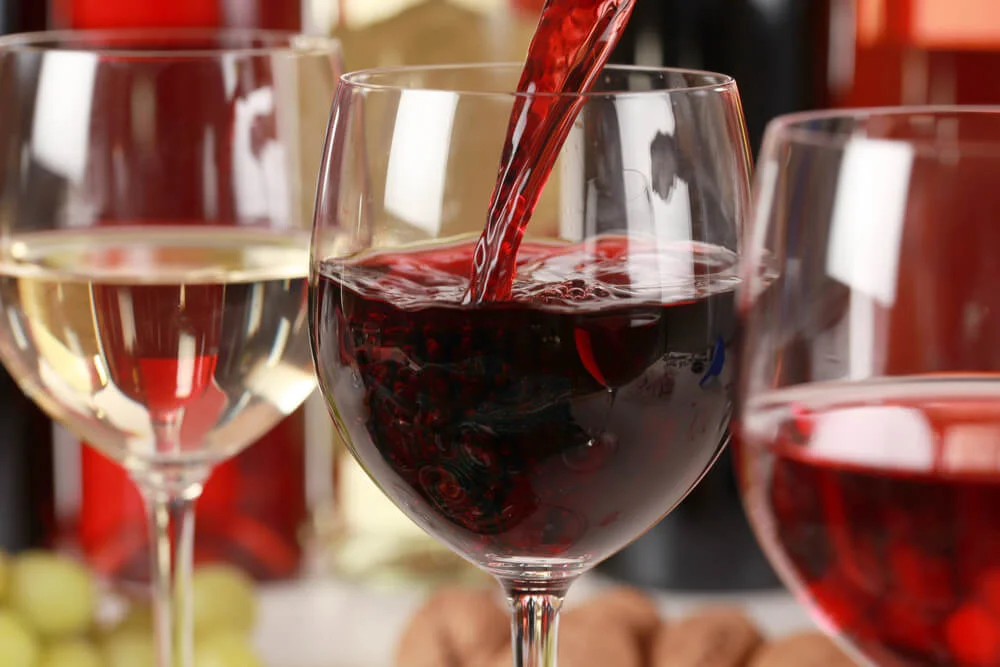
How long do wine tastings usually last?
The duration of a wine tasting can vary depending on several factors, such as the number of wines being tasted, the style of the tasting, and the preferences of the participants. In general, a wine tasting can last anywhere from 30 minutes to a couple of hours.
For a standard wine tasting that includes a flight of wines, typically ranging from 4 to 8 samples, the duration may be around 1 to 1.5 hours. This allows enough time to evaluate and discuss each wine without feeling rushed. However, if the tasting includes additional elements, such as a guided tour, food pairings, or educational presentations, it may take longer.
Do you tip at wine tastings?
Tipping is not customary at wine tastings. Most wine tasting venues, including vineyards, tasting rooms, and wine bars, do not require you to provide the person assisting you with the tasting a gratuity.
The cost of the wine samples and the service is often covered by the tasting price that you pay. However, as conventions might change, it’s always a good idea to double-check the establishment’s exact policies before you go.
You are not required to leave a tip, but you may do so if you feel the service was excellent or the event was exceptionally delightful. Keep in mind that enjoying and learning about the wine itself should be the primary goal of a wine tasting, not worrying about proper tipping behavior.
How about costs?
In general, the cost of a wine tasting can range from being free at some vineyards or wine shops where the cost is already included in the purchase of wine or a bottle fee to moderately expensive tastings that may cost between $10 and $30 per person for a typical flight of wines. These tastings usually provide a variety of wines to sample along with some background knowledge or instructional materials about the wines or wine area.
Wine tastings that are more specialized or costly, such as those that feature expensive or rare wines, are led by a sommelier, or are matched with gourmet foods, can be more expensive and can cost anywhere from $50 to several hundred dollars per person. With extra services, such as individualized attention, in-depth wine instruction, or special wine and food pairings, these tastings may provide a more elevated experience.
Conclusion
Now that you have read all of our tips and advice on wine tasting etiquette, we have just one last tip that is probably also the most important one, enjoy yourself and have some fun.
Even if some people are very serious about wine, it’s perfectly okay to laugh, crack a joke and have fun at a wine tasting. Enjoy the scenery and the picturesque vineyards. Make it a memorable experience.
